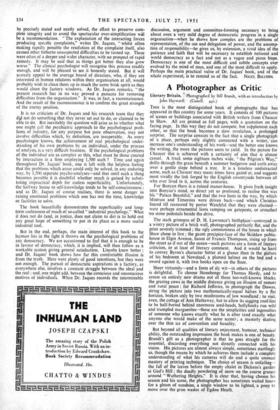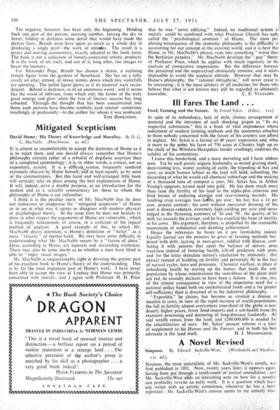A Photographer as Critic Literary Britain. Photographed by Bill Brandt,
with an introduction by John Hayward: (Cassell. 4;s.) THIS is the most distinguished book of photographs that has appeared in this country for some years. It consists of 100 pictures of scenes or buildings associated with British writers from Chaucer to Shaw. All are printed as full pages, with a quotation on the facing page. In this way they do not compete, but suliplement each other, so that the book becomes a slow revelation, a prolonged surprise. The surprise consists' in the fact that a single photograph of a place, perhaps only slightly connected with a writer, can increase one's understanding of his work—and the better one knows the writing, the more the pictures seem to yield. In the picture for Chaucer this is achieved with a certainty of aim that is almost casual. A track some eighteen inches wide, "the Pilgrim's Way," drifts through the grass beneath a summer hedgerow and curls away over a gentle slope behind a tree. It is a timeless undistracted scene, such as Chaucer may many times have gazed at, and suggests most vividly the link forged by the English countryside between all who ever lived in it, across the centuries.
For Bunyan there is a ruined manor-house. It gives fresh insight into Bunyan's mind, so direct yet so profound, to realise this was his "Palace Beautiful," and that the two lions in the way, by which Mistrust and Timorous were driven back—and which Christian feared till reassured by porter Watchful that they were chained— were perhaps ornamental lions ramping on gateposts, or crouched san stone pedestals beside the drive.
The stark grimness of D. H. Lawrence's birthplace=conveyed in a wintry picture of a brick wall, photographed perfectly flat, and the print severely trimmed ; the ugly commonness of the house in which Shaw chose to live ; the gaunt precipice-face of the Skiddaw public- house in Elgin Avenue, haunt of Francis Thompson, rising up from the stceet as if out of the ocean—such pictures are a form of literary criticism, or at least of literary comment. And it would be hard to convey Byron's character better at a glance than in the picture of his bedroom at Newstead, a Plumed helmet on the bed and a sword against it, with two books open on the floor.
Sheer virtuosity—and a form of sly wit—in others of the pictures is ,delightful. To choose Stonehenge for Thomas Hardy, and to create an entirely new drama out of those too-well-known blocks, the grazing cows in the middle.distance giving an illusion of remote and rural peace ; for Richard Jefferies, to photograph the Downs, string the picture into two mathematically-equal halves by a fiat horizon, broken only by two mushrooms of low woodland ; to visit, even, the cottage of Ann Hathaway, but to allow its sagging roof-line to be half-buried behind enormous seed-heads, hollyhocks run wild and trampled marguerites—these are the simplicities and ingenuities of someone who knows exactly what he is after (and exactly what anyone else would make of the same scene) ; a masterly skating over the thin ice of convention and banality.
But beyond all qualities of literary enjoyment, humour, technical ability, the outstanding impression the book makes is one of beauty. Brandt's gift as a photographer is that he goes straight for the essential, discarding everything not directly connected with his vision. His pictures are almost always simple, sometimes startlingly so, though the means by which he achieves them include a complete understanding of what his cameras will do and a quite unusual mastery of printing technique. The choice of season is unfailing— the fall of the leaves before the empty chalet in Dickens's garden at Gad's Hill ; the deadly powdering of snow on the coarse grasses around " Wuthering Heights." It is clear that, having chosen his season and his scene, the photographer has sometimes waited hours for a gleam of sunshine, a single window to be lighted, a pony to move over the grim wastes of Egdon Heath.
The negative, however, has been only the beginning. Holding back one part of the picture, stressing another, forcing the sky to lower, folding in darkness some detail that would have made the picture fussy, Brandt must have spent as much as a whole day in producing a single print—the work of mines. The result is a severe and moving commentary, exactly adapted to the book form. The book is not a collection of loosely-associated artistic products. It is the work of art itself, and out of it, long after, rise images to haunt the memory.
For Alexander Pope, Brandt has chosen a statue, a reclining female figure from the gardens of Stourhead. She lies on a lofty couch, an altar, almost, of mossy stones, down which tiny waterfalls are spouting. The pallid figure glows as if its material were incan- descent. Behind is darkness, as of an enormous wood ; and it seems like the wood of oblivion, from which only the forms of the truly great emerge and glow when the fuss of literary success has long subsided. Through the thought that has been concentrated into them, such pictures have become symbols, each related—sometimes touchingly or profoundly—to the author for whom it was produced.
Tom HOPKINSON.



































 Previous page
Previous page